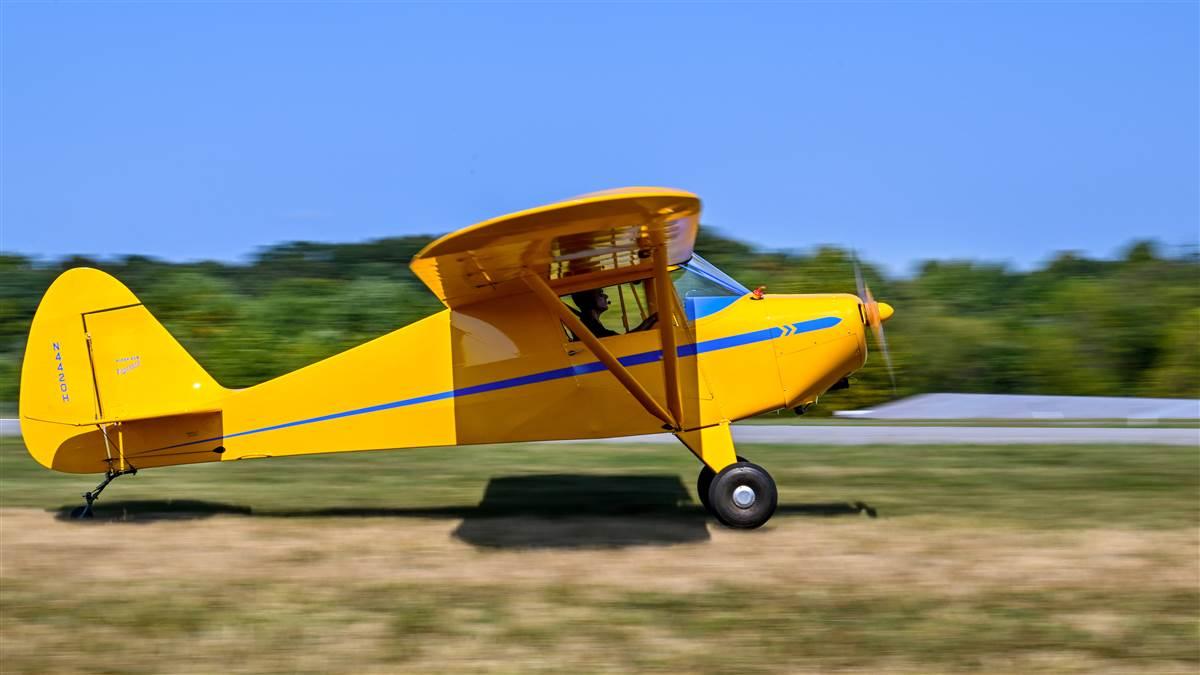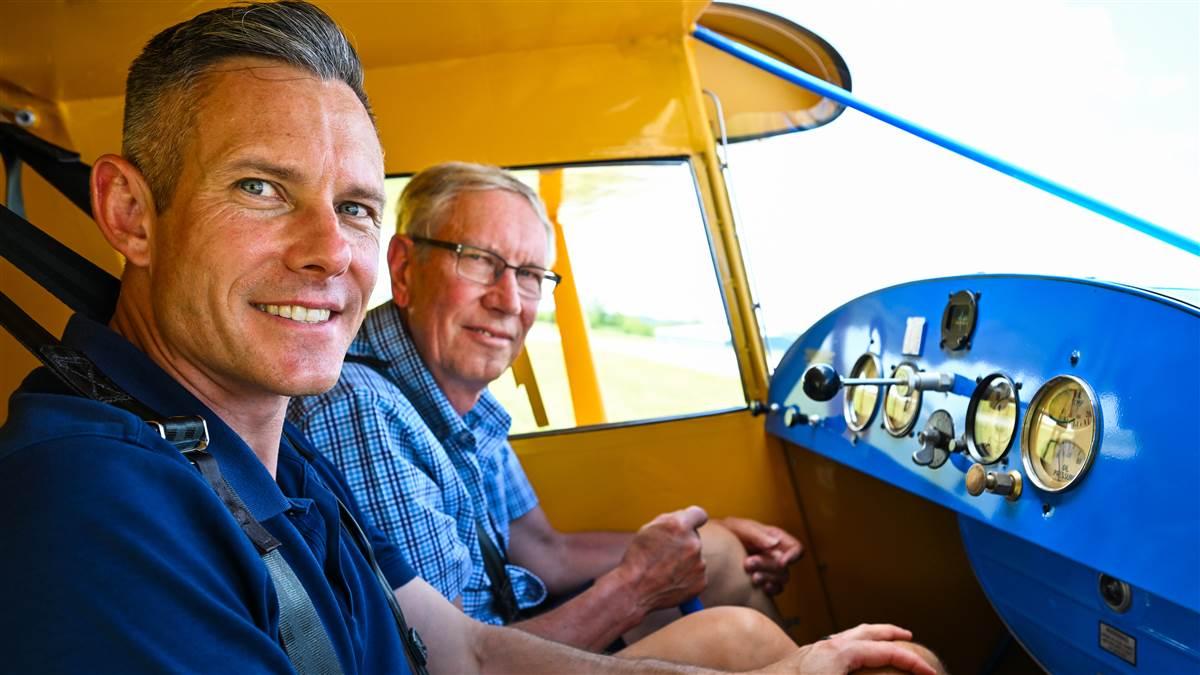The preacher's Vagabond
Three generations and a little Piper airplane

As the Rev. Duane Hauser flew his little yellow Piper Vagabond around the lake area, he read scripture, preached, and played hymns. The people on the ground at the state parks the young pastor flew over must have looked up in amazement as the small airplane flew overhead. At 800 feet, could they have actually heard his words and felt the power, or did they only fleetingly hear music and an occasional burst of his message?
Dennis Hauser remembers his father’s flights and the message his father wanted to share. “Growing up, I was the stick man. I would fly while he was speaking on the little amplifier. It was his way of evangelizing, asking them to come to church, to vacation Bible school,” Hauser said. “My father called it his ‘pulpit in the sky.’ It was stenciled on the side of the airplane. It helped fill the pews in church on Sunday.”

Second chances
Piper’s J–3 Cub was the iconic symbol of civil aviation before World War II. But after the war, manufacturers misjudged the demand for small aircraft and Piper was on the verge of bankruptcy. Its banks told Piper to go back to the drawing board and in six weeks come up with a new design but based on the parts it already had in inventory. And so, Piper designed the side-by-side seat Vagabond, a contrast to its tandem seating Cub, and produced two models, the PA–15 and the PA–17. The 15 was economical with a single set of controls and no suspension system. The 17 was designed as a trainer and it had dual controls. Piper made more than 300 Vagabonds, saving the company from bankruptcy.
“They marketed it as the aircraft that saved Piper,” said Dennis Hauser, recalling that his father had always regretted selling his PA–17 in the 1970s. Since he had learned to fly in that Vagabond, Hauser had always expressed to his own sons, Nathan and Ryan, both pilots too, that he would like to find it one day and buy it.
“My dad always said when he retired, he wanted to purchase that Vagabond one day,” said Nathan Hauser. “He said it was the most fun airplane he ever flew and wished it had not been sold out of the family. So, we got to looking for years for that airplane, but it was off the registry. And one day we were actually in Oshkosh for EAA AirVenture and it popped up on the registry and we contacted the owner and asked if we could buy it. He said no.
“My father was not happy with that answer, but we convinced him it was the answer he would have to accept. I stumbled on this project at the Massey Aerodrome [in Maryland] in June 2016. I sent a photo to my dad, but he said, ‘That’s not the one I want.’ But I bought it anyway. He retired and a week or two later I said, ‘I bought you a retirement gift.’”
The father and son started on the restoration of the 1948 PA–15 but separately. “I was working at my house on some things, and he would work at his house on some things and every now and then we’d get together,” the younger Hauser said. Both live in southeast Pennsylvania where Dennis Hauser retired from the Hershey Co. and Nathan works in marine transportation. They fly out of New Garden Airport (N57) where both are active in the EAA chapter there.



Heart and soul
The Rev. Hauser was living in a nearby assisted living facility and was very active on his iPad. Nathan would often reach out to his grandfather and ask about parts or how something worked. He also continued talking with the original owner of his grandfather’s Vagabond, the PA–17, as the owner was also restoring it. Around Thanksgiving several years ago, Nathan bought the original Continental engine from the Vagabond owner to put into his restoration.
“He and I got to be friends. We’d pass parts and templates back and forth. He sold me the engine, which my father and I restored. My grandfather saw the engine logbook on Thanksgiving at my house and I said to him, ‘Your name’s all over it.’ His eyes got real big and he said, ‘Where did you get this?’ and I said, ‘I bought the engine and it’s out in the garage.’ You’ve never seen an old man move so fast to go out and see his old engine.”
His grandfather looked over the engine and they realized the last time major work had been done on it was when Dennis Hauser had changed a cylinder in 1972. The heart of the original Vagabond was now in the Hausers’ restoration.
“The first time we had it fired up with the wings on and Dad got to taxi around I asked him, How does it feel?” and he said, “It feels like home,’” Nathan said.
“My grandfather visited on several occasions while we were restoring it, which was kind of neat for him to be a part of it. And we’d use FaceTime on the iPad. It was fun to have him included,” he said. They also painted a Bahama blue stripe on the aircraft like Rev. Hauser had on his Vagabond. Rev. Hauser did not get to fly in the restored Vagabond; “The Flying Pastor” died just before Christmas 2024 at the age of 98.
Piper Cub Vagabond






Glory and honor
The Sentimental Journey Fly-In Reserve Grand Champion was awarded to Nathan Hauser in June 2024 in Lock Haven, Pennsylvania. Both Nathan and his father Dennis were humbled.
“I was actually quite surprised to be awarded a trophy at Sentimental Journey,” said Nathan. “There were some pretty spectacular examples that showed up for the fly-in. We did feel pretty confident. We did a nice finish job on the airplane and mechanically did most of the work. All of the sheet metal work except for the nose bowl is custom by us. When we started restoring this airplane my dad did say, ‘I think this project will be a lot bigger project than what you think.’”
Dennis and Nathan worked on the restoration for more than four years. “When we first bought the airplane, the fuselage was mostly together and most of the welding work had been done, but the rest of the aircraft was pretty much in shambles, just a pile of parts,” said Nathan.
“It also didn’t come with an airworthiness certificate and no logbooks. The last time it had flown was 1956 and prior to late 1956, aircraft weren’t issued lifetime airworthiness certificates. They were issued an airworthiness certificate as part of the annual inspection. Technically this aircraft had an expired airworthiness certificate. Kind of an interesting challenge you don’t hear of everyday. We had to do a conformity inspection once the aircraft was complete.”
And how does it fly? “Oh, it’s a lot of fun. And I think Dad really likes it. The first time we flew it together he said, ‘Boy I forgot how maneuverable it is.’ It’s pretty touchy. It’s just a fun airplane to fly. You can kid around and it’s very responsive. It’s an airplane that keeps your attention.” 






